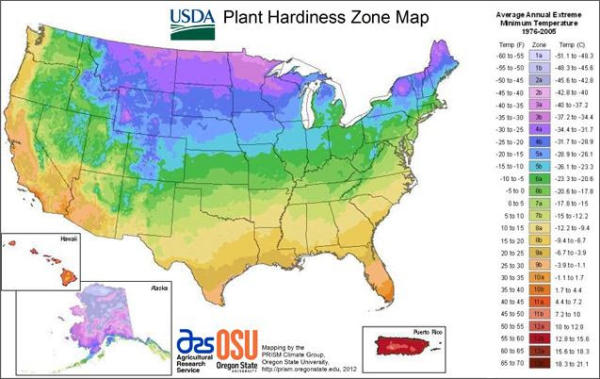 |
Many factors influence how successful your food plot and deer attractant plants will be, not the least of which is climate. That's why it's important to choose plants that are specifically adapted for the climate in your area. One of the best tools for determining this is the USDA Plant Hardiness Zone Map.
Long considered the standard by which gardeners and growers determine which plants are most likely to thrive at a specific location the Plant Hardiness Map divides the nation into 10-degree F zones based on average annual minimum winter temperatures. These zones or regions are then used to describe the range in which plants are adapted to and can be grown.
To ensure you pick the right plants for your region, Chestnut Hill Outdoors lists these Zones for each of their products. From North to South - Dark Purple is Zone 4, Blue Zone 5, Dark Green Zone 6, Pale Green Zone 7, Yellow Zone 8, and Tan Zone 9. They also check all orders to ensure plant species are appropriately suited to their destinations.
Use the link to plug in the zip code where you will be planting .
USDA Plant Hardiness Plant Zone Map Link
http://planthardiness.ars.usda.gov/PHZMWeb/
This will get you started, but it's important to note that inside these zones, variation in elevation, site location, directional orientation and proximity to bodies of water can create greater temperature variations at a specific site. These so-called micro- climates can enhance or hinder the growth rates of particular plants and are an important consideration in choosing where to plant.
For example, fruit trees that break dormancy early could be damaged by late season frosts that settle into frost pockets at the bottom of valleys or even swales, but may do better on hillsides where the cold air drains off to the bottom and does not damage the trees. Another example is south-facing slopes, which are warmed by winter sun and protected from prevailing cold north winter winds.
In general you should try to pick a location that avoids low lying frost pockets or areas that stay wet in the spring for extended periods during snow melt. You should also match the plant hardiness rating not just to the plant hardiness zone on the USDA map, but also to the specific micro-climate at the site.
Chestnut Hill Outdoors is more than just a nursery. In order to ensure you receive the maximum benefit from their products, they also provide sound advice and instruction on proper planting and care. For more on Chestnut Hill Outdoors products and how to care for them, visit ChestnutHillOutdoors.com, or call (855) 386-7826.
 |
|
|
 |
|
|
Chestnut Hill is the best place for you to purchase your food plot and deer attractant plants because they offer a large selection, their plants are specifically bred to attract deer, and they offer customers different sized plants at different levels of growth. |
|
For more information, please visit |

